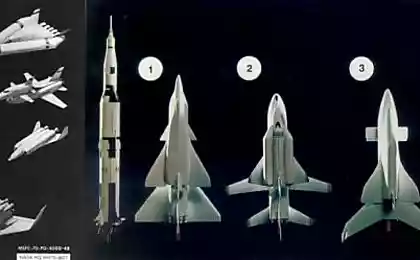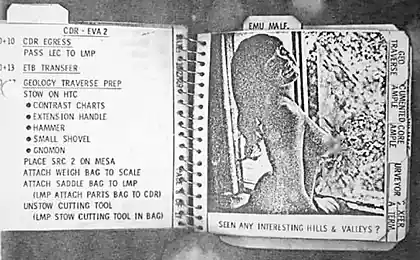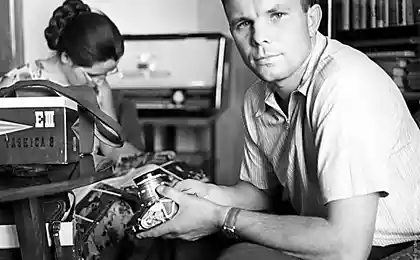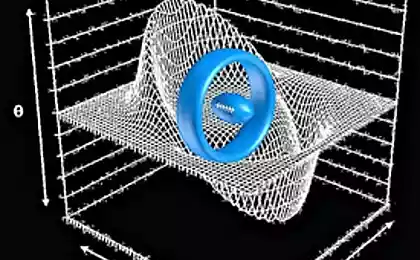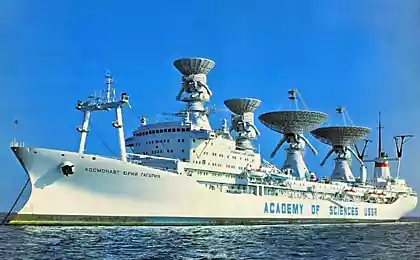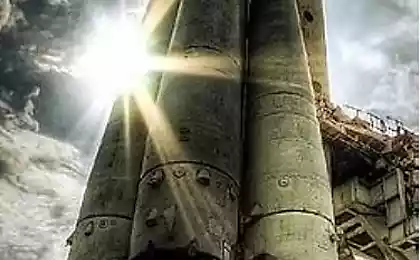A bold plan that could save the shuttle "Columbia". Part 3
Thimbles h5> During the rescue operation several actions have been performed for the first time. B> i>
- from the application D.13 report of the Commission of Inquiry of the shuttle disaster "Colombia» i>
Now ( after docking shuttles - approx. Interpreter i>) the complexity of the mission reached its peak. Depending on fatigue and physical condition, CM1 and CM2 could help the pilot and commander of Atlantis in the problems associated with retention of the ship at the desired orbit (assuming that the CM1 and CM2 would commander Rick Husband and pilot William McCool with Colombia). However, two additional spacesuit would continue to actively use.
Two members of the crew of Atlantis remained outside, and while CM1 and CM2 would remove suits, two with Atlantis would use their SAFER satchels for testing casing and the front edge of the wings (Columbia had such SAFER backpacks, so off-board inspection by the crew would require a much more sophisticated techniques to navigate the Orbiter to look at the wing).
Previous CM1 and CM2 spacesuits ready for use again. EV1 and EV2 returns them to Colombia in the sluice chamber in which pressure is equalized and then is opened. Two other crew members of Colombia to this point has already had to put on spacesuits that they were taken to the first flight. We call them CM3 and CM4. They repeat actions CM1 and CM2 and move on Atlantis.
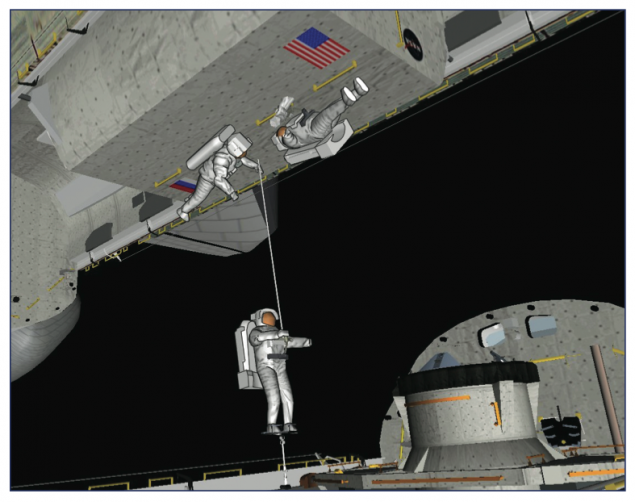
Another view of the astronauts move between Columbia and Atlantis. Source: NASA / CAIB Report i>
The report sounded the best possible scenario, when the suits on and off without delay. In this case, all the motion could be made without interruption. This means that the EV1 and EV2 would be outside of the 8.5 to 9 hours for one output.
However, it is hard to believe. Putting on the suit is not an easy operation even in the world with the full gravity and with a lot of sharp-eyed assistants. Don the suit in the central compartment, perhaps still trying oklematsya from poisoning by carbon dioxide, a much more complicated procedure. The fact that with each successful movement of crew members, reduced the number of assistants, also facilitates the task. It is likely that this step could be stretched to several spacewalks - instead of nine hours it could take three times as much.
After the first two movements of the pair, the following would be a single. CM5 moved to Colombia with one C helps EV1 and EV2. This is done simply because Colombia had seven people on board, and one person had to be without a pair. Leaving the last two, CM6 and CM7, together, it is assumed that they will help each other in putting on the suit. Ars ( site, that hosts the original article i>) interviewed several sources to determine how difficult it is to put on the suit without help someone someday without a spacesuit. Although no one spoke on the record, all came together in summary form on the fact that it is the task of enormous complexity.
Shooting Star h5> Features mend Colombia was not. B> i>
- from the application D.13 report of the Commission of Inquiry of the shuttle disaster "Colombia» i>
Before leaving, the last two people with Colombia had to make a few final action. Orbiter was to be prepared to seize control from the ground to remove the shuttle from orbit.
There was no chance to repair the shuttle. Even if the wing could be patched up and cool down, while changing the configuration of the entry into the atmosphere to increase the angle of attack and reduce the temperature of the leading edge of the wing, it is unlikely that Colombia would survive. Furthermore, even if a successful entry into the atmosphere would have been possible, it was impossible to land the shuttle only from Earth - MCC was unable to push the shuttle's landing gear and control the air intakes ( air probes , serve to determine the atmospheric pressure Overboard - approx. interpreter i>), necessary for the evaluation of the velocity in the atmosphere . These functions (as well as the inclusion of an auxiliary power unit) can be performed only physical dip-switch in the cockpit during the approach and landing.
The remaining shuttles were able to fit under the full control of Earth in 2006, with the help of the developed RCO IFM 8.5-meter cable braided, which could be used by the crew for a physical connection with the cockpit electronics compartment of the shuttle, and give access to DVGA desired switch.
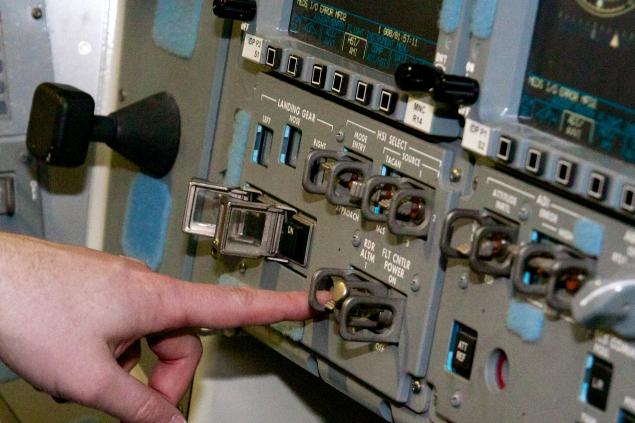
Switches chassis (left) just before commanding point. They are among the few systems that could be remotely controlled from earth. Source: Steven Michael i>
At Columbia had no such opportunity. CM6 and CM7 would have to go to the Flight bay of the shuttle and several toggle switch in place, giving DVGA with direct access to the Earth-based navigation and maneuvering of Colombia.
CM6 and CM7 then would go away with the shuttle, closing the Airlock and leaving Colombia to seek their own way home. Atlantis slowly be removed from the fraternal ship and its crew of 11 people would occupy themselves preparing for the ordeal enters the atmosphere with crowded people apparatus - ever Orbiter not landed with 11 crew members, and even simple things like seating would be complicated. Few people would have to literally sit tied to the floor during reentry.
At some point within a few hours or days, terrestrial operators were ordered to close the Columbia cargo compartment door and orient themselves to the latter problem. Shuttle turned to damaged thermal tiles to earth and made a deorbit burn to his large OMS ( Orbital Maneuvering System, a system of orbital maneuvers - approx. Interpreter i>) engines. After a while he'd crossed the boundary of the atmosphere ( «entry interface», the entry point into the atmosphere at an altitude of 121 km - approx. Interpreter i>).
Contrary to popular opinion, the heating of the spacecraft during re-entry is the result not so much friction as drag - a fast-moving shuttle pushes air in front of him, forming a massive impact zone where the air molecules are ionized and fly apart. During descent, Colombia, the observer in the flight compartment windows would see the glow and radiance of the plasma. After a short time, this plasma would penetrate into the structure of the shuttle through a hole in the wing.
Last Action Colombia would glow in the sky above the South Pacific, first as a luminous star, and then divided into many. Remains of the old space shuttle would dotted surface of the Pacific Ocean, and nothing more.
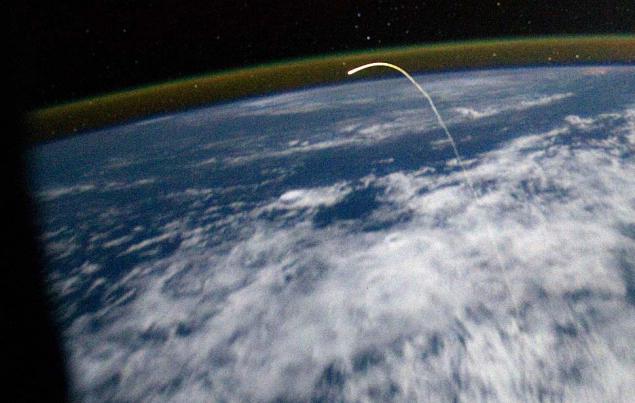
Glowing ionized trail from the entrance to Atlantis in the atmosphere during the last flight in the program Space Shuttle. Photographed from the ISS, 21 July 2011. Source: NASA i>
To the stars through the thorns h5> It should be noted that although each separate element under the best scenario would be executed so that the rescue mission would be successful, but the overall risk while reducing the time training and preparation for higher than the individual elements. i>
- from the application D.13 report of the Commission of Inquiry of the shuttle disaster "Colombia» i>
We all love the ending like in the movies, but it's hard to imagine that a rescue mission would have passed with the required level of integrity. For example, in a study for this article, I have not met a single case when the shuttle passes through the Orbital Processing Facility ( is the author of error, hangar called Orbiter - approx. Interpreter i>), Vehicle Assembly Building and procedures launch facility without error and failure. Based on the complexity of the system, I suspect that this never happened.
Oh, and when faced with a challenge of this magnitude and with such dire consequences, the incredibly attractive imaginary picture in which NASA has taken on this task. NASA, as a public body, simultaneously represents all the best and worst of the US - he has some of the greatest engineering achievements in human history and a long list of goals achieved, which were originally considered unenforceable. At the same time, the agency mutilated lack of leadership and initiative. It has evolved from an organization is able to deliver the person to other worlds in an organization that does not even have the ability to transport people into low Earth orbit without any help.
Thus, the mission of salvation Colombia shows this type of problems for which NASA, since its foundation, has expressed unwavering confidence in their performance. This was to be a clear objective, there would be a strict time frame, and a huge staff of engineering talent agency would have to be authorized to complete this goal at any cost and without restrictions.
The desire to win would not be a problem, but the technical challenges are not aware of the desires and motivations - look, for example, to the explosion of the tank with liquid oxygen, which mutilated command and service module Apollo 13 in 1970. This explosion was the result of a combination of events that occurred before run, with the possible guilt of individuals stretching from workers producer tank until themselves crewmembers . Infallible salvation Colombia would have to depend not only on the perfect work team at NASA, but also from an unknown number of events that occurred days, weeks, months or even years before the start of the mission.
In the investigation for this article, I spoke with a large number of works and works at NASA people who are both inside and outside the Mission Management Directorate ( Missions Operation Directorate - approx. Interpreter i>). Everyone was polite, but no one agreed to speak at a record on the feasibility of the proposed mission of salvation Colombia. The official response I received from the department of public relations NASA, respectfully but firmly informed me that the CAIB report is complete and official position of NASA in this case:
From the point of view of NASA, there is nothing more to add to the report of the Commission of Inquiry of the shuttle disaster "Columbia" (Chapter 6 and its applications) as to "what if" -stsenariya rescue crew STS-107. As you know, it was announced very clearly what should have been a very large number of well-known facts to then carry out the mission of salvation, or repair of Colombia.
...
In conclusion, we respectfully refuse to give any interviews on this particular subject and refer you to the report CAIB for detailed analysis carried out during the investigation of the accident Colombia.
Blockquote>
Ultimately, the application D.13 this assumption, based on the research and all the information developed by the engineers who closely familiar with the program space shuttle mission. My story about the rescue of history is not intended to criticize or blame NASA for their actions, and I'm not trying to "hindsight" to reconsider the choice of making decision-makers, who now must live with the consequences in the form of graves because most of these decisions. Columbia and her crew almost exactly could not be saved without a lot of "ifs" to turn in their direction. I can tell the story of what might be the most awe-inspiring moment of all human space flight, but I'm too unskilled to argue outside report CAIB.
This is an amazing story, but it's just a story.
The long road home h5> It is unlikely that the space launch vehicles will ever be the same routine matter, as well as commercial airline flights - definitely, it will not happen during the lifetime of someone anybody who reads this. Scientists and engineers continue to work on the best opportunities, but if we want to continue to go into outer space, we must continue to take all the risks. B> i>
- The report of the Commission of Inquiry of the shuttle disaster "Colombia» i>
Return of flying at NASA took 907 days after the destruction of Columbia. STS-114 - Flight Discovery instead of Atlantis - up from Cape Canaveral July 26, 2005. I remember it very well - now as a not-so-junior system administrator, I watched helplessly as a substantial number of employees of Boeing looks at the countdown and launch video on NASA TV, scoring our local Internet channel. A little funny that it almost led to an attempt on the part of our management query delay takeoff (Boing office in Houston provided support for the shuttle, and some of these actions required to support an Internet connection). The launch was successful.
Starting with STS-114, none of the shuttle did not take off without saving the machine in standby mode. Such planned extra flights (numbered STS-3xx) called LON-mission , which means «Launch On Need» (< i> startup if necessary - approx. interpreter i>). In case of problems, the main shuttle mission, the crew had to make a rendezvous with the ISS and take refuge there for up to 50 days until the LON-shuttle would result in readiness for the flight to take them.
The only exception was the last mission to service the Hubble, STS-125. The height of the orbit and its inclination to the Hubble mission did absolutely incompatible with the possibility of an emergency meeting with the ISS in case of problems, so the plan was made salvation, partly based on the scheme of Atlantis / Columbia. Mission STS-125 LON duplicated STS-400 . Due to the fact that the option was not available to the ISS, Endeavour STS-400 from would have to be ready to run in a short time, and this has led to what is already a rare occasion to exclusive: два shuttle were fitted on LC-39 simultaneously
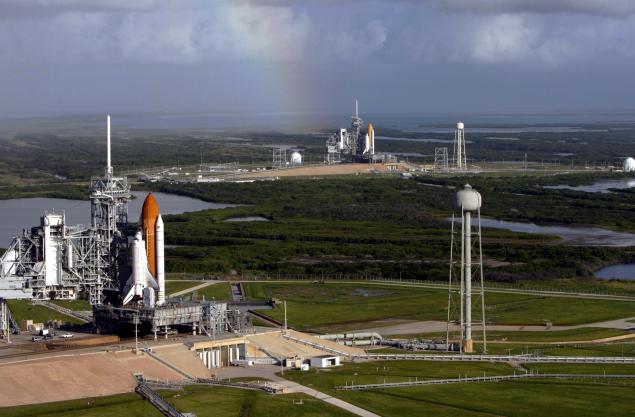
.
Source: NASA / WikiMedia Commons i>
Neither mission LON never needed, and the shuttle program ended without other significant incidents. Beats breakaway foam were not eliminated, but the volume was increased postheating analysis of each shuttle. This is certainly actually what future manned space program will return to its NASA rightful place atop the spacecraft launches faster than if all remained in their places. Culture NASA continues to develop. It is impossible to say at this point whether all the lessons of Colombia have been studied in the agency.
I was here during the impact assessment and the return to flight, but all agency policy changes far beyond my competence. The single most vivid recollection was the memorial service after the destruction of Columbia.
February 4, 2003 h5> The path of exploration and discovery is not the choice that we did - it's destiny written in the human heart. We are that part of creation which tries to understand the very creation. We are looking for the best among us, send them forth to the unexplored darkness and pray for their return. They rest in peace for all mankind, and all mankind in their debt. B> i>
- President George W. Bush, in a letter personnel Johnson Space Center i>
We arrived at the Johnson Space Center around 9:30 am informed that the number of seats will be limited to the service, which will begin at noon. After a half-mile walk and security check, we took a seat in the center of the structure 16, lost among a sea of people. Platform and podium were far away at the other end of the grassy field, and we spent two and a half hours on my feet in an uncomfortable silence. After a long wait, Air Force One, accompanied by three F-15S, whirled on the descent to the airport Ellington Field. The crowd swelled to its maximum immediately after 11. At noon, without fanfare, President Bush and first lady Laura Bush have traveled together to their places on the platform. They held hands, that imprinted in my mind - even the most powerful man in the world, holding the hand of his wife.
After the prayers were the director of NASA and Chief Astronaut Corps. Both paid tribute to each individual astronaut and Head Covers obviously struggling with tears. The president walked to the podium next and spoke eloquently about the human spirit. Only close to the policy of the words left his mouth, were completely relevant - he said that the space program will continue. After that, he also talked about each astronaut personally, praising their courage and dedication.
Ship's bell rang seven times, according to the number of crew members of Colombia, and then 4 aircraft NASA T-38s flew in formation «Missing Man». The planes flew low and fast, zipping past us wedge less than a hundred meters above the ground.





